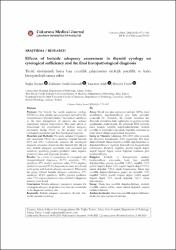Effects of bedside adequacy assessment in thyroid cytology on cytological sufficiency and the final histopathological diagnosis
Citation
Toyran, T., Güvendi, G.F., Adalı, Y. & Üstün, H. (2020). Effects of bedside adequacy assessment in thyroid cytology on cytological sufficiency and the final histopathological diagnosis. Cukurova Medical Journal, 45(3), 1173-1181. https://doi.org/10.17826/cumj.733150Abstract
Purpose: the thyroid fine needle aspiration cytology (FNAC) is a fast, reliable, and economical method for interpretation of thyroid nodules. This method contributes to the later management of patients and reduces unnecessary surgical interventions. This study aimed to demonstrate the contribution of bedside adequacy assessment during FNAC to the accuracy rates of cytological competence and final histological diagnosis. Materials and Methods: the study included 443 patients who underwent FNAC in a university hospital between 2012 and 2015. Correlations between the histological diagnosis categories of patients who had and who did not have bedside adequacy assessment were compared per sensitivity, specificity, positive predictive value, negative predictive value, and diagnostic accuracy. Results: As a result of comparison of cytological and histopathological diagnoses, 30.7% sensitivity, 75% specificity, 50% positive predictive value, 57.1% negative predictive value and 55.1% diagnostic accuracy were found in the group with bedside adequacy assesment. Whereas the group without bedside adequacy assessment, 50% sensitivity, 69.2% specificity, 42.8% positive predictive value, 75% negative predictive value, and 63.1% 1% diagnostic were found Conclusion: Bedside adequacy assessment increases the cytological adequacy proportion, but does not contribute to the diagnostic accuracy rate.


















